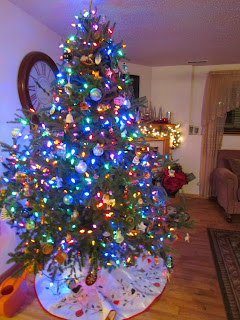I love Christmas. I love the decorations, the music, the feelings, the crazy hustle bustle of the season. I don't even really mind most of the fake evergreen smells that come out in candles, air fresheners, little scent sticks to hang in your artificial tree to help you pretend it's real, and a variety of other means. But there is nothing I love more than the smell of fresh, real Christmas trees.
When artificial trees first came on the market, they were marketed as a more environmentally friendly way to celebrate the season, rather than cutting down all those real trees. What we didn't talk about was the fact that those artificial trees don't look good forever. After a few years, they become tattered and ratty looking and we decide to shop for a new tree. Those tattered trees end up in the landfill, where they take many, many decades to decompose. They use up beneficial nutrients from the soil as they are decomposing, however, they don't add anything back to the soil in the process. That's a lose-lose.
Real trees are a renewable resource. Across the country, for every real evergreen harvested, at least three new seedlings are planted. Now, being a gardener, I know that not every one of those seedlings lives and grows to become someone's Christmas tree a few years down the road. But, those that do survive serve multiple purposes. As they are growing, they are helping to clean and oxygenate the air around them; they are providing shelter for wildlife and birds; they are beautifying the fields in which they are grown; they end up beautifying our homes after they are cut; and finally, they can help us out with some of our winter chores in the gardens. That's a win-win.
Once it's time to remove the tree, we bundle it up in a huge plastic bag and carry it out to the garage. There, I unwrap it and start the work of cutting off all the branches. The bare trunk gets thrown out into the wood pile. The branches then become mulch for the roses, perennials, young trees, or whatever else needs a good sturdy layer of mulch that isn't likely to be blown around by the North Dakota "breezes". The branches catch the snow and make a nice insulating layer over the vulnerable plants, but they don't become packed down like other mulches can. This allows more oxygen to get to the plants and creates a better overall environment for them. In very harsh winters, if we have any birds that decide to stay in the north country over the winter months, I will place suet packs or pans of sunflower seeds or safflower seeds in amongst the piles of branches and the birds can safely enjoy their own winter buffet.
Another benefit of using the evergreen branches for mulch is cat control. My kitties are pretty good about not using the garden areas for their beds or litter boxes in the summer, but in the winter, they just look for whatever snow is easy to dig in. They are not inclined to dig around in the prickly, stickery evergreen branches, though, so I can keep them out of vulnerable garden areas.
When spring arrives, I give the clump of evergreen branches a good whack or two to knock loose needles down to the ground, where they will become rich compost over the course of the summer. The branches and any clinging needles get tossed into the compost pile. The trunk of the tree, minus the branches, gets cut into firepit size pieces so the enjoyment of that Christmas tree can last well into the summer. The trunk can also be chipped and used for mulch in the gardens.
I am not anti- artificial tree, (I love Christmas enough that I decorate several Christmas trees each year and some of them are artificial trees) but all in all, that real Christmas tree is a great investment. And you just can't replace that true evergreen scent.


No comments:
Post a Comment